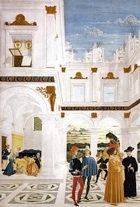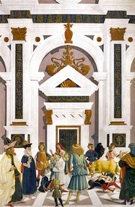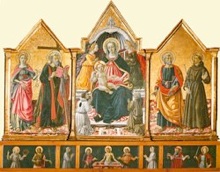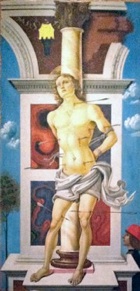

Little is known about this artist, although both of the works with which he is associated by documented survive (see below). There is evidence to suggest that he was a close associate of Bartolomeo Caporali:
-
✴Bartolomeo seems to have been the co-ordinator of the Workshop of 1473 (see below), to which Sante di Apollonio probably belonged;
-
✴both artists contributed to the Triptych of Justice (1475-6); and
-
✴Bartolomeo seems to have been an executor after the death of Sante di Apollonio in 1486, in which capacity he received payment for the upper panel (1485) of the Decemviri Altarpiece (see below).
Miracles of St Bernardino of Siena (1473)


St Bernardino restores to life St Bernardino revives
a baby that has died at birth Nicolò di Lorenzo da Prato,
who has been trampled by a bull
Some scholars believe that Sante di Apollonio belonged to the so-called Workshop of 1473, which produced the important panels depicting miracles of St Bernardino of Siena that are now in the Galleria Nazionale. (Follow the links in the page on the Workshop of 1473 for more details). Two of the eight panels (the bottom two on the right, illustrated here) are specifically attributed to him.
Triptych of Justice (1475-6)

This triptych from the Oratorio dei SS Andrea e Bernardino was generally attributed to Fiorenzo di Lorenzo until Michael Bury (reference below) discovered a document in the archives of the Confraternita di Sant' Andrea della Giustizia that records its commission from Bartolomeo Caporali and Sante di Apollonio del Celandro. The altarpiece was originally in the confraternity's church of Santa Mustiola, and it moved with the brothers to the Oratorio di SS Andrea e Bernardino in 1537. It was given to the Commune before 1872 and entered the Galleria Nazionale in 1895.
-
✴In the central panel, two members of the confraternity kneel before the Madonna and Child, who are flanked by a pair of angels.
-
✴The side panels depict:
-
•SS Mustiola and Andrew; and
-
•SS Peter and Francis.
-
It is significant that St Mustiola holds the Virgin’s wedding ring, because this relic (the Santo Anello), which had long been associated with Santa Mustiola at Chiusi, had been stolen in 1473 and brought to Perugia. (It is now in the Cappella del Santo Anello in the Duomo).
-
✴The predella depicts:
-
•SS Bernardino and John the Baptist, on the left;
-
•the Pietà with the Virgin and St John the Evangelist at the centre, flanked by another two members of the confraternity; and
-
•St Jerome and a soldier saint on the right.
St Sebastian (ca. 1476)

Decemviri Altarpiece (1495-6)
The Decemviri (ten magistrates) originally commissioned an altarpiece for their chapel in the Palazzo dei Priori (now part of the Galleria Nazionale) in 1479 from Pietro di Galeotto. The main panel was to depict the Madonna and Child with SS Laurence, Louis of Toulouse, Herculanus and Constantius, while the smaller upper panel could be of a subject of his choice. Although the contract stipulated that a steep penalty would arise unless the work was delivered within two years, it remained incomplete at the time of Pietro’s death in 1483.
In 1484, the commission passed to Perugino, who was to complete the main panel within four months and to paint the upper panel within a year. The subject of the latter was to be the Madonna della Misercordia with portraits of the Decemviri, who would presumably be depicted sheltering under her cloak. When Perugino left the city a month later without having started the work, the commission passed to Sante di Apollonio, who executed the upper panel, which depicted the Madonna della Misercordia. He seems to have lost the commission in 1485, and he died in the following year. This upper panel was subsequently painted over.
Read more:
M. Bury, “Bartolomeo Caporali: a New Document and its Implications”, Burlington Magazine, 132 (1990) 469-75
Return to Art in: Perugia.

